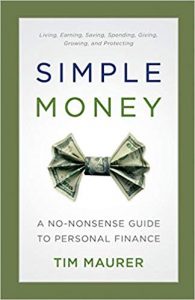Review Simple Money: a no-nonsense guide to personal finance
by TIM MAURER
Description
Tim Maurer claims that personal finance is more about the person than it is about finance. In Simple Money, he breaks down complex aspects of personal finance and breaks them down into a digestible read. He encourages readers first to state their goals and values before they proceed to plan their money management, which he says is an easier way to get ahead.
He tackles various aspects of personal finance like intelligently budgeting expenses, reducing debt, paying for insurance, and creating a financially comfortable retirement plan. Overall, Maurer encourages readers that personal finance is not as complicated as they think—and that it is actually doable.
This book is a great introductory guide to personal finance as it condenses really complicated topics into easily understandable ones. Topics are divided into chapters and subchapters, which allows the readers to focus on the ones they think are most important and can skim on the rest of the book. It discusses the basics in a very well-detailed manner, which makes it informational, too.
The book also notes that personal behavior and habits have a big impact on your financial plan. The author encourages readers first to state their goals and values to get a clearer perspective of how they want their financial management to be. Another advantage of the book is that it includes guidelines that the readers can easily follow as they move their way to financial comfortability.
About the Author
TIM MAURER is a financial advisor, author, speaker, and blogger. He is the director of personal finance in BAM Alliance, which is an organization of more than 140 financial advisory firms providing service to 190,000 individuals in the United States. He regularly writes articles for Forbes, Time/Money, CNBC, as well as on his blog. He has coauthored financial books and has been chosen to be one of the twenty financial advisors that compose CNBC’s Financial Advisor Council.
Table of Contents
Part 1: Planning for Life
Part 2: Planning for Today
Part 3: Planning for the Inevitable
Part 4: Planning for the Unexpected
Part 5: Planning for Action
Acknowledgments
Notes
About the Author
